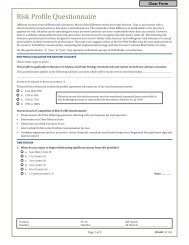The Inflation Cycle of 2002 to 2015 - Uhlmann Price Securities
The Inflation Cycle of 2002 to 2015 - Uhlmann Price Securities
The Inflation Cycle of 2002 to 2015 - Uhlmann Price Securities
You also want an ePaper? Increase the reach of your titles
YUMPU automatically turns print PDFs into web optimized ePapers that Google loves.
Industrial Portfolio Strategy<br />
<strong>The</strong> <strong>Inflation</strong> <strong>Cycle</strong> <strong>of</strong> <strong>2002</strong> <strong>to</strong> <strong>2015</strong> ⎯ April 19, <strong>2002</strong> -83- Legg Mason Wood Walker, Inc.<br />
Franklin D. Roosevelt effectively “nationalized” the U.S. monetary gold supply in 1933, ordering that all (monetary)<br />
gold must be turned in<strong>to</strong> the Federal Reserve System in exchange for $35 per troy ounce <strong>of</strong> U.S. currency. <strong>The</strong>reafter,<br />
the U.S. Mint would buy, but not sell domestically, gold at $35 per ounce. Since this price was a sharp devaluation <strong>of</strong><br />
the U.S. dollar’s prior legal weight in gold, Europe had little choice but <strong>to</strong> follow the U.S. devaluation, since a huge<br />
“avalanche” <strong>of</strong> foreign gold began <strong>to</strong> make its way <strong>to</strong> the U.S., greatly increasing banking reserves. Second, the New<br />
Deal programs increased the role <strong>of</strong> the federal government. And third, the U.S. Supreme Count upheld the 1935 National<br />
Labor Relations Act, enabling workers <strong>to</strong> organize and employ strikes for better wages. As a result, 1933 <strong>to</strong> 1937<br />
featured a 53% increase in the U.S. money s<strong>to</strong>ck, <strong>of</strong>fsetting most <strong>of</strong> the one-third decline in money s<strong>to</strong>ck from 1929 <strong>to</strong><br />
1933. By 1937, U.S. real incomes had recovered <strong>to</strong> a level that was 3% above the 1929 peak, since the preliminary effect<br />
<strong>of</strong> inflationary policies is <strong>to</strong> shrug <strong>of</strong>f the stagnation <strong>of</strong> the prior deflation. But the pursuit <strong>of</strong> unilateral self-interest<br />
by the U.S. and other nations made the world a more dangerous place by the late 1930s, replete with trade and foreign<br />
exchange restrictions, competitive devaluation and rising political extremism in Europe. In the modern period, perhaps<br />
the competitive devaluation <strong>of</strong> the European euro and Japanese yen mark a return <strong>to</strong> economic unilateralism. In<br />
the case <strong>of</strong> Europe, politicians seem unwilling <strong>to</strong> make the structural adjustments <strong>to</strong> avoid reliance on devaluation,<br />
and in the case <strong>of</strong> Japan, a weaker yen appears <strong>to</strong> be an act <strong>of</strong> economic desperation. <strong>The</strong> beginning <strong>of</strong> World War II<br />
in Europe in 1939 produced events similar <strong>to</strong> World War I, with an initial inflow <strong>to</strong> the U.S. <strong>of</strong> gold <strong>to</strong> purchase<br />
goods, and such purchases were later funded by U.S. credit <strong>to</strong> our allies. Monetary policy served the war effort, and U.<br />
S. budget deficits averaged about 30% <strong>of</strong> GNP from 1942 <strong>to</strong> 1945 after the U.S. entered the war. For the entire war period<br />
September 1939 <strong>to</strong> August 1948, the U.S. money s<strong>to</strong>ck rose 12.1% per year, and wholesale prices rose 8.7% per<br />
year. <strong>Inflation</strong> was restrained by price controls from early 1942 <strong>to</strong> mid-1946. Those controls were instituted <strong>to</strong> contain<br />
the sort <strong>of</strong> inflation that had occurred in World War I. But as traditional economic theory would suggest, the side effects<br />
<strong>of</strong> price controls included substitution price differentials, barter, and a thriving black market. After 1948, there was a<br />
revival <strong>of</strong> prudent monetary policy, but the outbreak <strong>of</strong> hostilities in Korea in 1950 triggered a renewed round <strong>of</strong> commodity<br />
inflation and hoarding (Exhibit 10, point labeled “B”). As his<strong>to</strong>rical parallels would suggest, this late stage<br />
speculative blow-<strong>of</strong>f heralded the end <strong>of</strong> the preceding inflation mentality (similar <strong>to</strong> 1920) and the start <strong>of</strong> a deflationary<br />
economic and s<strong>to</strong>ck market boom in the 1950s and early 1960s.<br />
Deflation from 1952 <strong>to</strong> 1964 then led <strong>to</strong>…<br />
<strong>The</strong> Commodity <strong>Inflation</strong> <strong>Cycle</strong> <strong>of</strong> 1965 <strong>to</strong> 1981 In 1944, the Allied Powers economic ministers signed the Bret<strong>to</strong>n<br />
Woods Agreement, so named for the ski resort in New Hampshire at which talks were held. In accordance with the<br />
agreement, from 1947 until the system was abandoned in 1971, the U.S. agreed <strong>to</strong> exchange U.S. dollars for gold at $35<br />
per ounce (for foreign treasury signa<strong>to</strong>ries), and member governments agreed <strong>to</strong> peg their currencies <strong>to</strong> the gold-backed<br />
U.S. dollar. Combined with the U.S. manufacturing and service base that emerged from World War II unscathed, the<br />
primacy <strong>of</strong> U.S. economic and political power was sealed. <strong>The</strong> U.S. enjoyed a golden age <strong>of</strong> power in the 1950s that we<br />
do not believe was seen again until the fall <strong>of</strong> Communism ushered in a similar period <strong>of</strong> hegemony in the 1990s. But,<br />
as his<strong>to</strong>ry has shown, reliance on a “leading” central bank <strong>to</strong> put currency bloc altruistic interests ahead <strong>of</strong> nationalist<br />
interests was a fatal flaw. <strong>The</strong> “Guns and Butter” policy <strong>of</strong> pursuing an aggressive social agenda in the 1960s as part <strong>of</strong><br />
President Johnson’s “Great Society,” while simultaneously fighting a prolonged war in Vietnam, led <strong>to</strong> deficits and a<br />
debasing <strong>of</strong> the U.S. dollar. In a hauntingly similar parallel <strong>to</strong> <strong>to</strong>day, we note that the cost <strong>of</strong> the War on Terrorism is<br />
just beginning <strong>to</strong> rise. Also similar <strong>to</strong> the 1960s, the Great Society cost may pale in comparison <strong>to</strong> the medical and<br />
Social Security costs associated with the aging <strong>of</strong> the Baby Boom generation. By year-end 1965, U.S. capacity utilization<br />
was about 90%, and unemployment was only 4.0% versus the 5.5% average from 1960 <strong>to</strong> 1965. This fullemployment<br />
economy collided with fiscal and monetary stimulus <strong>to</strong> undermine the price stability discipline <strong>of</strong> Bret<strong>to</strong>n<br />
Woods. No longer wishing <strong>to</strong> import U.S. inflation, the U.K. and France teamed up <strong>to</strong> challenge the U.S. by demanding<br />
that their dollars be converted in<strong>to</strong> gold in the summer <strong>of</strong> 1971. In response, President Nixon closed the U.S. gold window<br />
on August 15, 1971, ending the Bret<strong>to</strong>n Woods Agreement, and laying the foundations for the 1970s’ inflation. All<br />
that was missing was a catalyst, and we cite two. First, the wave <strong>of</strong> U.S. Baby Boomers born in 1946 began <strong>to</strong> graduate<br />
from high school in 1964 and college in 1968 or 1970, depending on military service. As each year passed, more<br />
“Boomers” required meaningful employment, which created the political imperative <strong>of</strong> a Phillips Curve full-








